As CentOS Linux 7 approaches End of Life (EOL) on June 30, 2024, many organizations are exploring their options and researching answers to frequently asked questions, including:
- What do I do about the CentOS Linux 7 end of life in 2024?
- Can I migrate these devices to Red Hat Enterprise Linux (RHEL)?
- How do I evaluate the risk and uncertainty of migrating CentOS Linux 7 systems that have been deployed in my environments?
At Red Hat, we have been listening intently. We are excited to offer multiple solutions to help organizations manage and maintain system deployments, both large and small, that are regularly updated with reporting tools to understand security and risk levels.
Options to tame your CentOS Linux sprawl
Red Hat has enhanced and integrated the Convert2RHEL tool into three different use case scenarios. This blog will focus on the third option—using Red Hat Insights.
1. Convert2RHEL command line tool
The Convert2RHEL tool has been supported since 2021 and used successfully by many large enterprise companies, including many in the telecom and financial sectors. A new enhancement includes a pre-conversion analysis phase available in all use case scenarios.
2. Red Hat Satellite integration with the Convert2RHEL utility
This feature extends the Convert2RHEL tool's experience to synchronize content on-premises using Satellite and job templates to help convert many systems at scale.
3. New! Red Hat Insights Tasks for system analysis and conversion
We are excited to provide this new, guided experience to help you analyze and convert CentOS Linux 7 systems to RHEL. Insights is provided as a service, so there is no infrastructure overhead to install. This guided experience reduces the complexity, risk and time required for your conversion to RHEL.
With Insights, you can:
- Connect your CentOS Linux 7 systems to Red Hat Insights.
- See your CentOS Linux 7 systems in Insights inventory alongside your RHEL systems.
- Initiate the Insights Task for pre-conversion analysis as a planning guide for migrating many systems at once. This will provide you with guidance on how to proceed.
- Initiate the Insights Task to convert the systems that are ready for conversion.
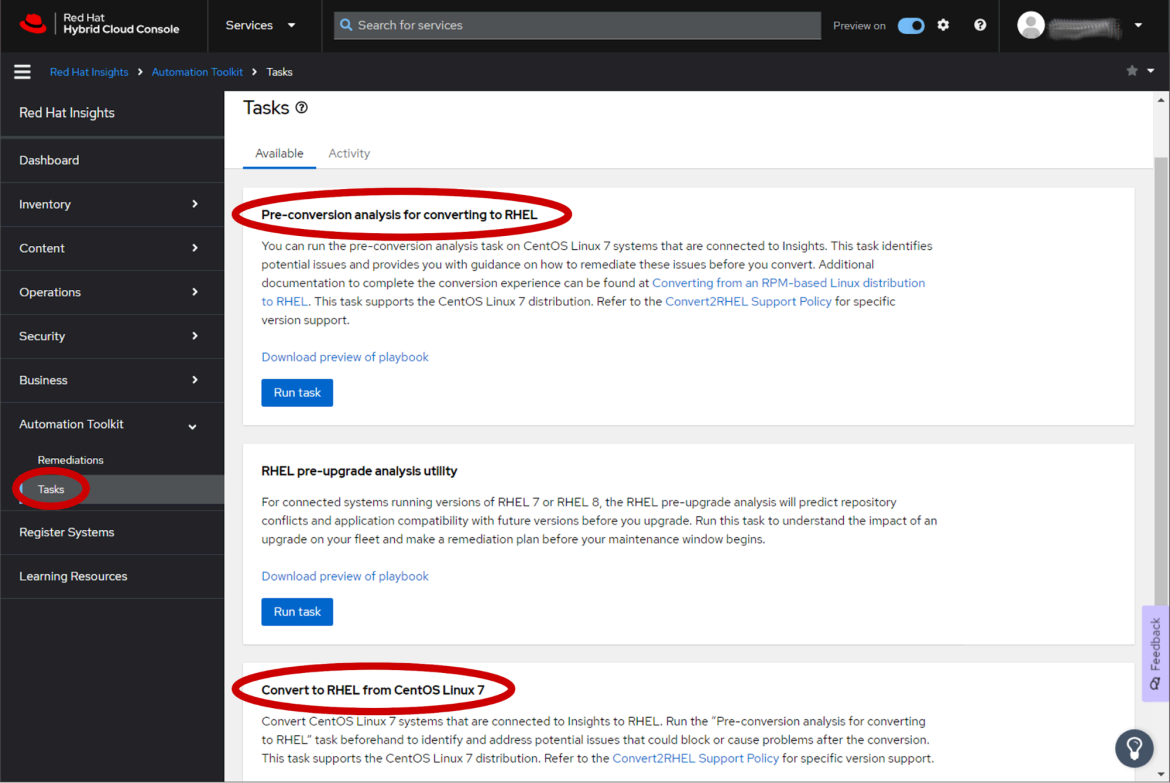
Give it a try
1. To get started, simply log in to Red Hat Insights. If you do not already have an account, you must create one first.
2. Make sure your account has at least one RHEL subscription. A subscription is required for your system to access RHEL content for analysis and conversion. This also unlocks your newly converted system to enable the full features and benefits of RHEL and Insights. If you do not already have a subscription, you can obtain one using the following options:
a. Developer Subscription for Individuals is available at no cost to use RHEL independently (not for an organization).
b. Working on a development project within your organization? You may qualify for a no-cost Developer Subscription for Teams.
c. To use RHEL in production, check out the options listed at RHEL for Third Party Linux Migration, a competitively priced subscription that also includes ELS.
3. Next, create an Activation Key and note your Organization ID. These are required for the next steps. Refer to the Getting started with activation keys on the Hybrid Cloud Console for further guidance.
4. Enable Simple Content Access (SCA) on your account. This provides the simplest experience to automatically enable subscriptions on the system. SCA is enabled by default for new accounts. For older accounts that may not have this option enabled, you may need to contact your company's Org Admin for the Red Hat account to enable SCA. You now have everything required to perform a complete conversion.
5. Log in to your CentOS Linux 7 system and connect it to Insights to use the new experience.
a. First, ensure the system is fully updated to the latest CentOS Linux 7.9 packages. Red Hat's testing and support are only for the latest package set. Restart the system to ensure it is running with the newest kernel.
# sudo yum update -y
# sudo rebootb. Next, install the Red Hat client tools to connect the system to Insights and display it in the Inventory. A detailed explanation for each of these files is provided in Chapter 4. Preparing for a RHEL conversion using Insights.
# sudo curl -o /etc/yum.repos.d/client-tools-for-rhel-7-server.repo https://ftp.redhat.com/redhat/client-tools/client-tools-for-rhel-7-server.repo
# sudo curl -o /etc/pki/rpm-gpg/RPM-GPG-KEY-redhat-release https://www.redhat.com/security/data/fd431d51.txt
# sudo yum install -y subscription-manager insights-client rhc rhc-worker-script
# sudo rhc connect --organization ORG_ID --activation-key ACT_KEY6. Congratulations! Your system is now connected and appears in the Insights Inventory.
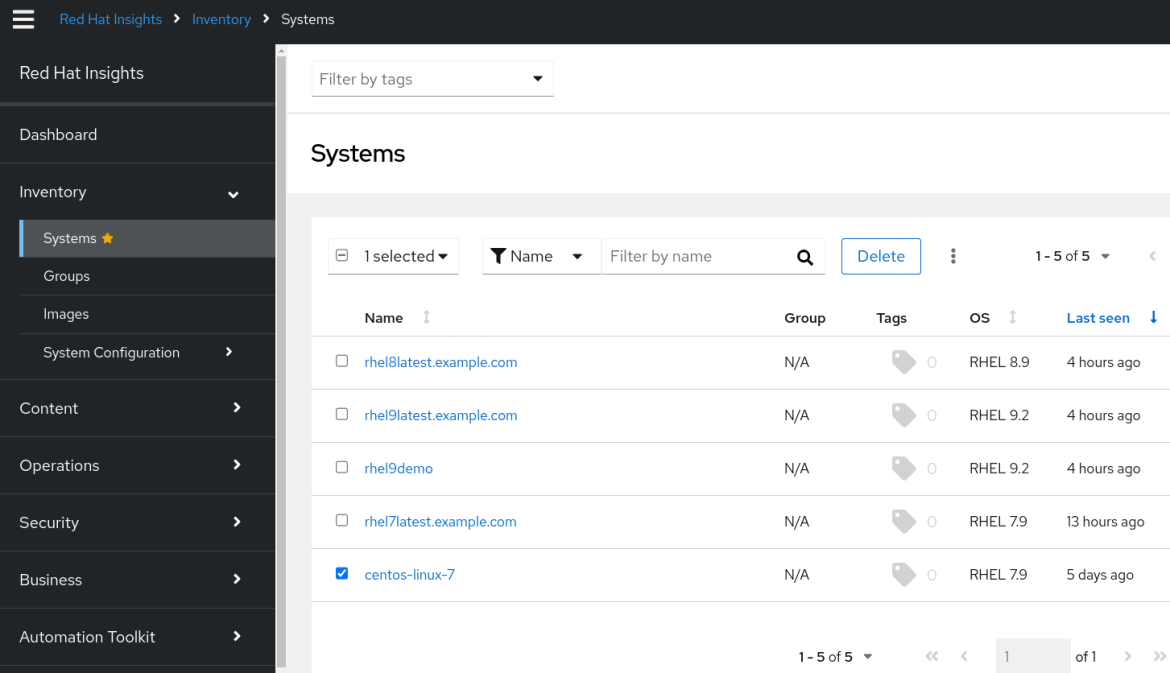
7. Next, expand Automation Toolkit from the left sidebar and select Tasks. Here, you will find the option to run the Task for Pre-conversion analysis to RHEL. Follow the instructions to initiate the analysis on the desired systems. Depending on the speed of the systems being analyzed, this could take 5-20 minutes to complete.
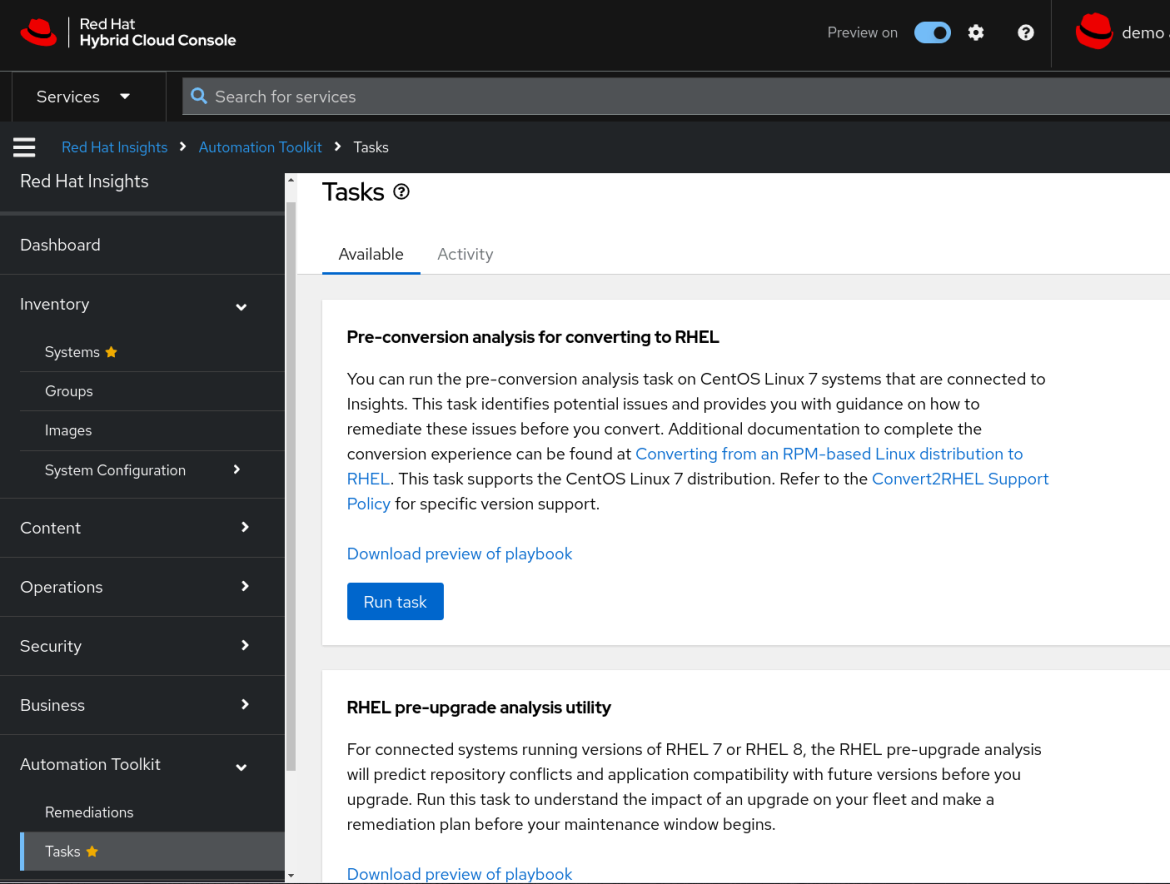
8. After the pre-conversion analysis task is completed, you may review the informational feedback provided. This may include information only or inhibitors in red text with guidance on remediating the issue discovered.
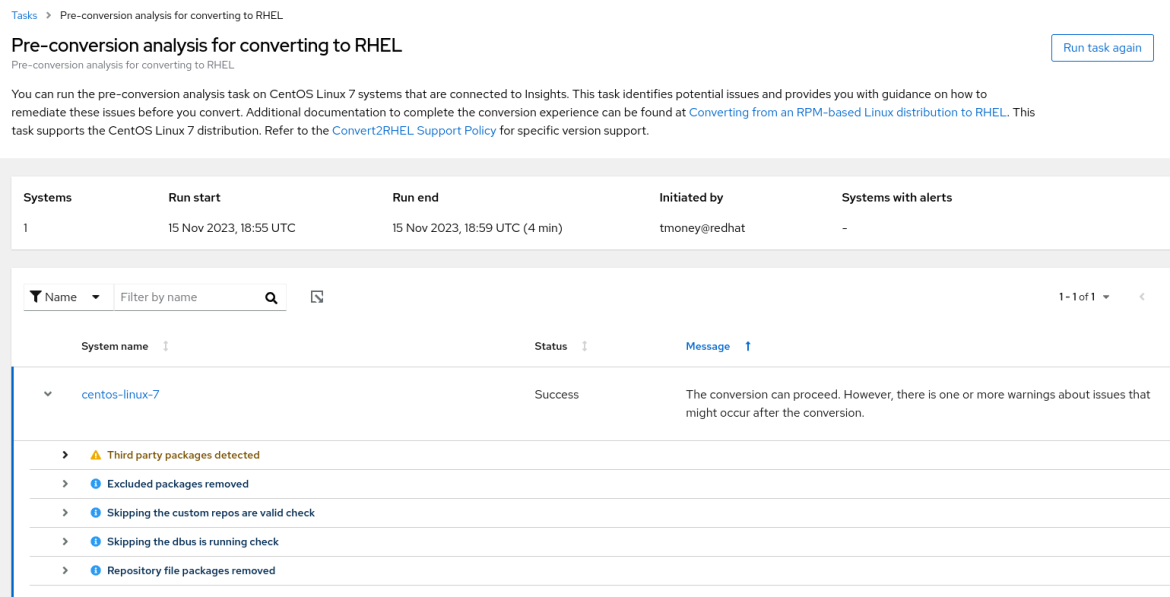
9. After reviewing the pre-conversion analysis and resolving any concerns, proceed with the Insights Tasks to Convert the system to RHEL.

10. You will be provided with an informational summary and status of success upon completion.
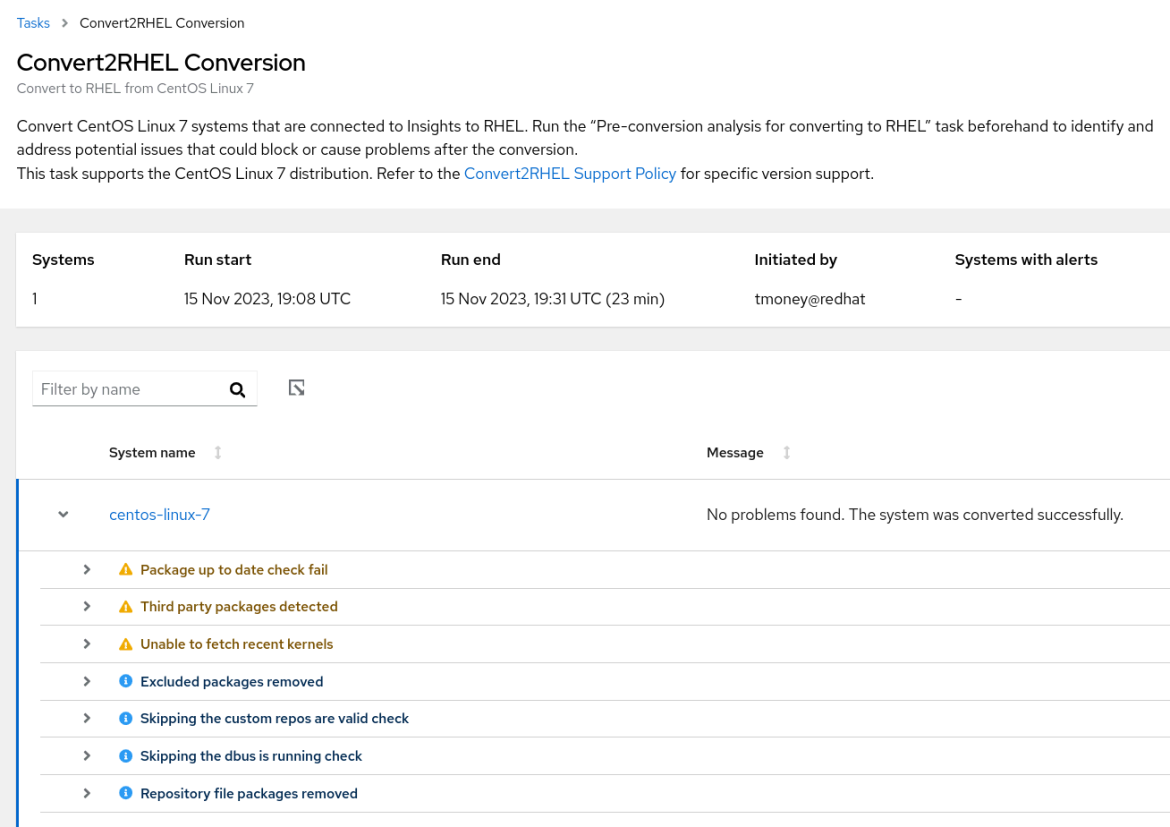
Looking forward
We will continue improving this Red Hat Insights conversion experience to make converting your CentOS Linux 7 workloads to RHEL easier than ever. Improvements include:
- Performance improvements to shorten analysis time.
- Executing playbooks to remediate CentOS systems using suggested advice from pre-conversion analysis.
- Consideration for additional, compatible Linux distributions as needed.
Providing feedback
We would love to hear from you! As you use the tool, simply click the purple Feedback button at the lower right to submit your comments, report a bug, or submit a feature request.
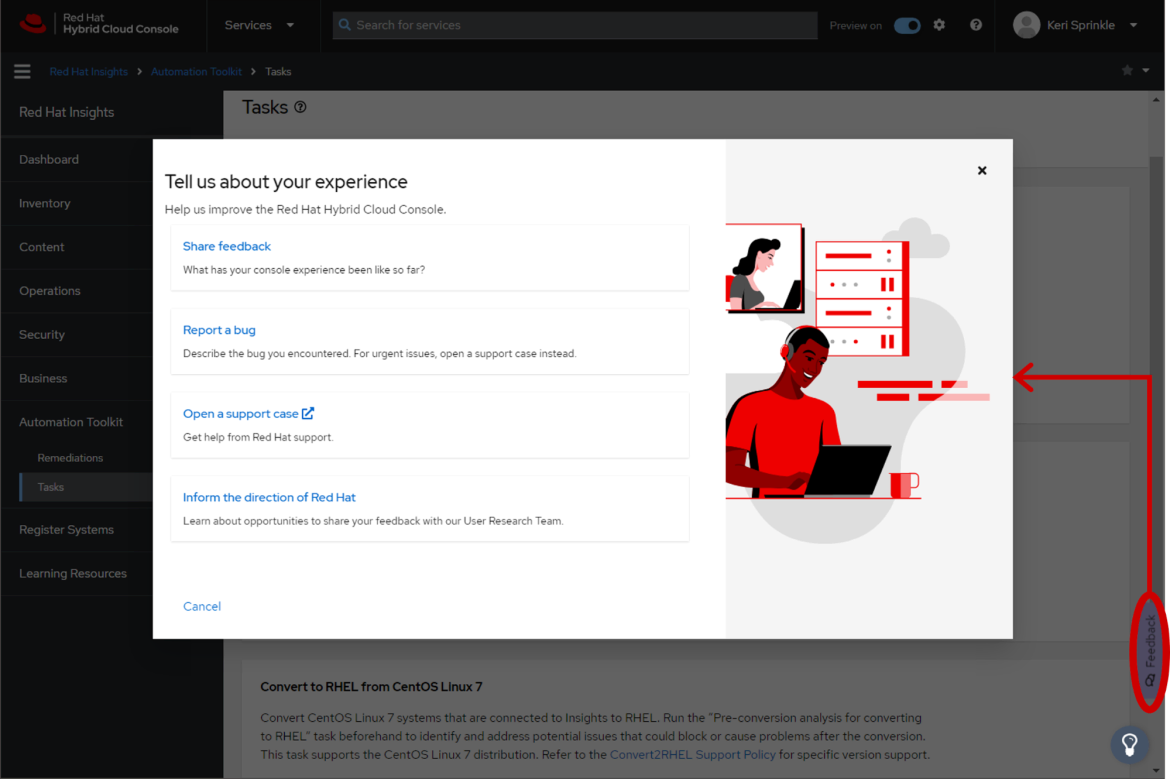
Interested in learning more?
The following links provide additional instructions and guidance on options for conversions and major release upgrades.
Conversions
New! Converting from an RPM-based Linux distribution to RHEL using Red Hat Insights
Visit https://red.ht/centos for additional resources and offers to help you migrate to Red Hat Enterprise Linux.
Major release upgrades
Once you've completed your conversion, be sure to check out our new RHEL upgrade page (located at https://red.ht/upgraderhel) for additional resources to help you prepare and upgrade to newer releases of RHEL.
Wrap up
If you are wondering what to do about your CentOS Linux 7 systems and their pending end of life in June of 2024, rest assured that you are not alone. Red Hat offers consulting services to assist with technical implementation and low-cost and no cost subscription options, depending on your needs. This includes RHEL for Third Party Linux Migration, a significantly reduced cost RHEL subscription that provides access to the Convert2RHEL tool and up to four years of extended life cycle support past the CentOS Linux 7 EOL date.
We also hope you see the value that your RHEL subscription provides beyond just the installed bits. Red Hat is committed to providing the best management experience for your RHEL systems, along with life cycle options, such as Extended Life Cycle Support, to plan your workload journeys from RHEL 7 to a more current release.
About the authors
Terry Bowling has been designing and working with customers on UNIX and GNU/Linux environments since 1999. He brings this experience to the RHEL Product Management team to provide the best experience to assembling and deploying RHEL for customers. This includes the RHEL installer, image builder and related build services for RHEL being developed at Console.RedHat.com.
Bob Handlin has helped build and promote products in various parts of the tech industry for more than 20 years. He currently focuses on RHEL migrations and upgrades, but also assists with storage technologies and live patching.
Browse by channel
Automation
The latest on IT automation for tech, teams, and environments
Artificial intelligence
Updates on the platforms that free customers to run AI workloads anywhere
Open hybrid cloud
Explore how we build a more flexible future with hybrid cloud
Security
The latest on how we reduce risks across environments and technologies
Edge computing
Updates on the platforms that simplify operations at the edge
Infrastructure
The latest on the world’s leading enterprise Linux platform
Applications
Inside our solutions to the toughest application challenges
Original shows
Entertaining stories from the makers and leaders in enterprise tech
Products
- Red Hat Enterprise Linux
- Red Hat OpenShift
- Red Hat Ansible Automation Platform
- Cloud services
- See all products
Tools
- Training and certification
- My account
- Developer resources
- Customer support
- Red Hat value calculator
- Red Hat Ecosystem Catalog
- Find a partner
Try, buy, & sell
Communicate
About Red Hat
We’re the world’s leading provider of enterprise open source solutions—including Linux, cloud, container, and Kubernetes. We deliver hardened solutions that make it easier for enterprises to work across platforms and environments, from the core datacenter to the network edge.
Select a language
Red Hat legal and privacy links
- About Red Hat
- Jobs
- Events
- Locations
- Contact Red Hat
- Red Hat Blog
- Diversity, equity, and inclusion
- Cool Stuff Store
- Red Hat Summit


